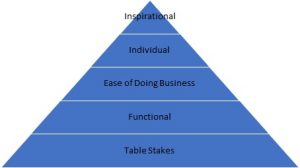Value as a cornerstone in B2B is a familiar idea. And the value is arrived at through the various value elements. Traditionally, these value elements were all understood to be equally important. New research by Almquist, Cleghorn, and Sherer (2018) finds that there is a hierarchy of elements, which have probably emerged through the evolution of B2B marketing. They find that there are 5 levels to these elements.
When thought of as a Pyramid (refer adjacent figure), these levels dictate the relative importance of the various elements in the final decision-making process. At the base are the table stakes such as meeting ethical standards and ensuring compliance, among others. Then come the functional value elements that cater to the customer’s performance needs such as quality and scalability. At the middle level, the authors propose elements that enhance the ease of doing business which includes productivity elements (eg. reduced efforts, reduced hassles), improved access (eg. variety, availability), improved relationship (eg. commitment, responsiveness). These elements could be at an operational level or at a strategic level. At the next level, the individual elements of value address items at the personal level (eg. reduced anxiety due to assurance) or career level (eg. reputational assurance). These elements operate at an emotional level. Finally, at the very top are elements that contribute to the purpose of the customer firm. These include elements that help the firm achieve its vision and enhance corporate social responsibility.

The authors then suggest from their research that the greater the number of higher-level value elements that the firm excels at providing to the customer, the greater is the customer loyalty and willingness to repurchase. Companies can systematically incorporate this new understanding by benchmarking their offering and the competitor offering on these value elements, creatively thinking about ways of increasing value to customers through the higher-level elements, implementing changes and then learning from them through the next round of benchmarking.
The pyramid structured identification of the elements of value helps managers quickly identify the critical areas that can provide the greatest returns.
Almquist, Cleghorn, and Sherer, in Harvard Business Review, 2018
Summarised by: Dr. Prakash Satyavageeswaran, Assistant Professor at Indian Institute of Management (IIM), Udaipur

